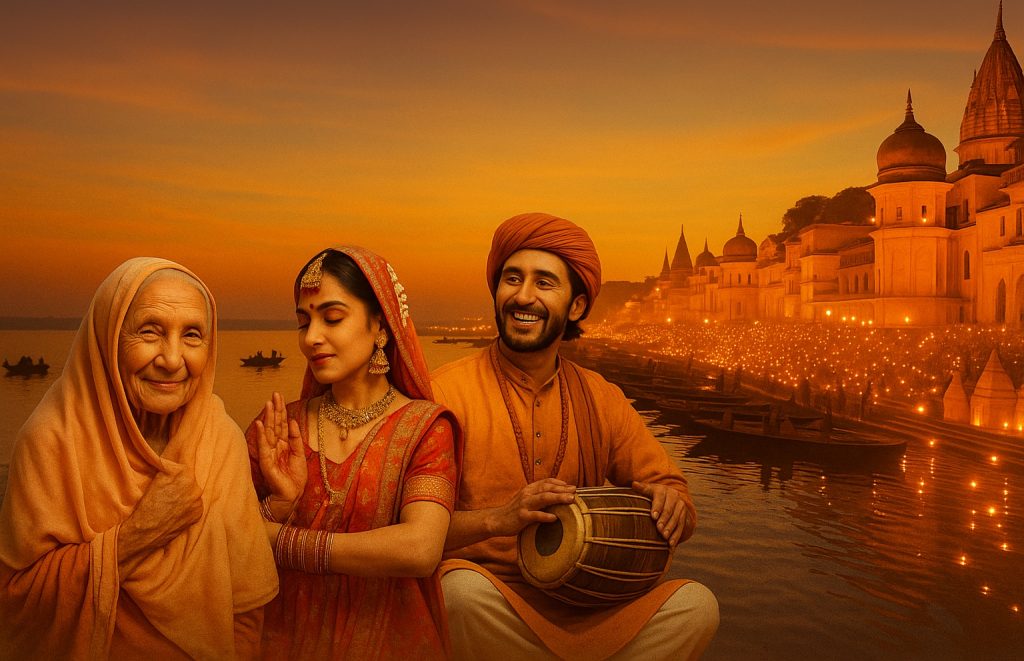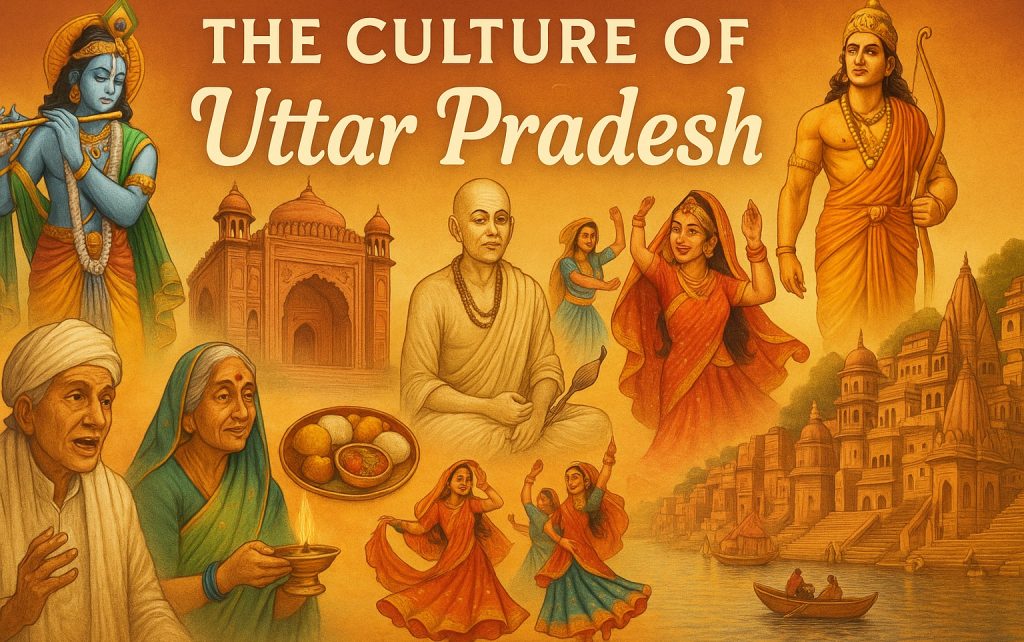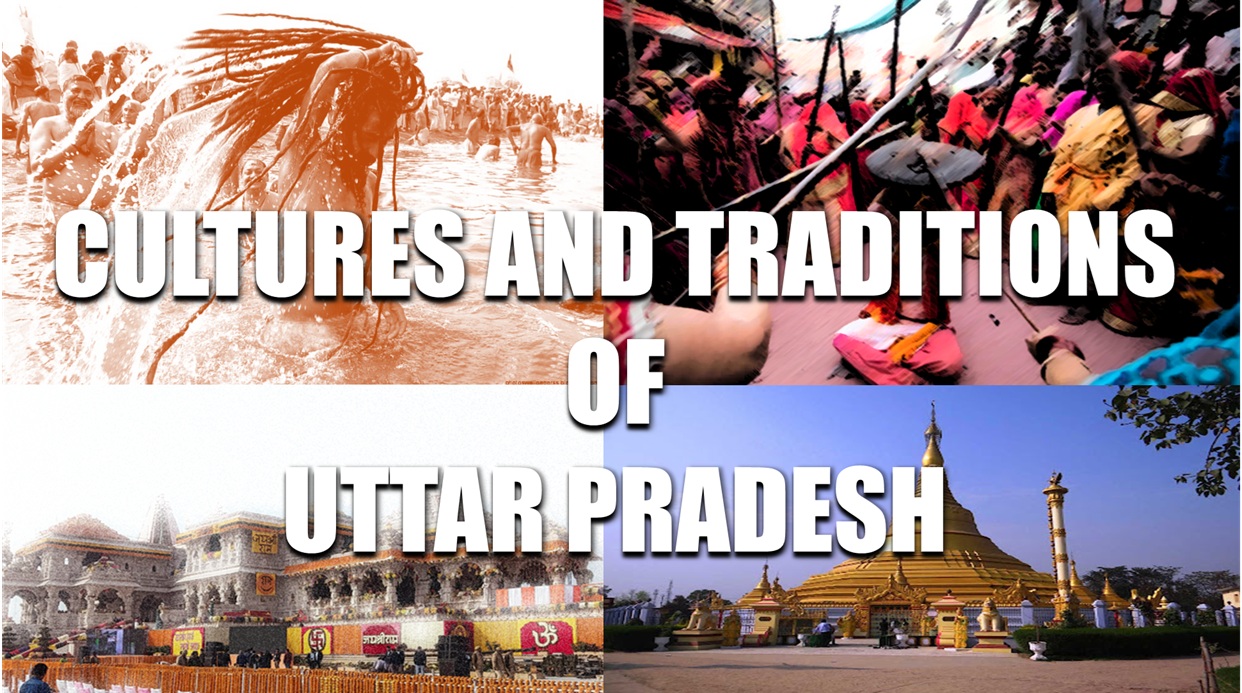Mitti Ki Khushboo: Celebrating the Living Culture of Uttar Pradesh
Uttar Pradesh is more than just a place on the map of India; it’s an emotion that lives in dialects, dances, deities, and deep-rooted memories. For the millions of people who have moved away from the ghats of Varanasi, the orchards of Malihabad, or the alleys of Allahabad [now Prayagraj], the culture of UP still flows in their veins like the Ganga itself.
This article is a nostalgic celebration of that very culture, specially written for the diaspora, dialect lovers, and cultural connoisseurs of Uttar Pradesh.
Language and Dialects: The Soul of Everyday Life
In Uttar Pradesh, you don’t just speak—you sing. The dialects here are not mere forms of communication but poetry in motion.
- Awadhi brings with it the elegance of Tulsidas.
- Bhojpuri carries the earthy strength of farmers and folk singers.
- Braj flows like the Yamuna, drenched in Krishna Bhakti.
- Bundeli, Kannauji, and many others tell tales of warriors and lovers.
For the UP diaspora, the memory of a mother calling out “beta, roti kha lo” in pure Awadhi or a grandfather reciting Kabir ke dohe in Bhojpuri brings instant tears. These dialects are not fading—they’re waiting to be passed down. From ancient poetry to Bollywood songs, UP’s dialects have shaped Indian culture in powerful ways.
Do you still speak in your mother tongue — Awadhi, Bhojpuri, Braj, or Bundeli — at home?
Folk Music and Dance: Rhythm of the Fields
From Kajri sung in the monsoon to Birha echoing through village nights, folk music in UP connects you to the soil.
- Kajri, Chaiti, and Dadra celebrate the changing seasons.
- Nautanki and Raslila mix theatre, storytelling, and devotion.
- Rai dance in Bundelkhand is full of vigor and tradition.
“Dholak ki taal, aur kajri ka raag—yehi to hai UP ka swag!”
Diaspora children might not have seen a Raslila in Mathura, but they carry the videos their grandparents recorded. The beat of the dholak has a way of making the heart remember.
Cuisine and Food Traditions: Taste That Tells Stories
UP’s food is less about recipes and more about relationships.
- Baati-Chokha in eastern UP is the flavor of village pride.
- Awadhi Biryani and Kebabs reflect Lucknow’s royal past.
- Kadhi-Bari, Tehri, and Puri-Sabzi bring festive warmth.
- Sweets like Gujiya, Thekua, Peda, and Imarti are edible emotions.
“Jo swaad dadi ke haathon ke thekue mein hai, woh kisi bakery mein kahan?”
For those abroad, the aroma of tadka in mustard oil or the taste of aam ka achaar brings home right back to the kitchen.
Festivals and Rituals: Celebrations That Bind Generations
UP celebrates life with colors, chants, and rituals passed down like heirlooms.
- Ram Navami in Ayodhya and Krishna Janmashtami in Mathura draw lakhs.
- Deepotsav in Ayodhya lights up the soul.
- Chhath Puja, Makar Sankranti, and Barsana Holi remain core to family traditions.
- Muharram in Lucknow reflects syncretic harmony.
“Tyohar sirf din nahi hote, yeh toh bachpan ke pal hote hain.”
The sound of temple bells, the sight of a diya-lit balcony, and even online darshans keep the spirit alive among NRIs.
Dress and Ornaments: The Fabric of Identity
Traditional clothing in UP is not just attire, but art with emotion.
- Sarees with seedha pallu, lehenga-choli, and angarkhas.
- Dhoti-kurta with safas in villages and sherwanis in cities.
- Ornaments like nath, jhumka, tikli, payal aren’t just accessories—they’re stories.
“Jab maa apna purana jhumka beti ko deti hai, toh sirf gehna nahi, sanskaar deti hai.”
Even diaspora weddings often turn to Banarasi silk, and the joy of dressing up in your roots never fades.
Architecture and Arts: Stones That Speak
From the Mughal arches of Fatehpur Sikri to the ghats of Varanasi and the temples of Ayodhya and Mathura, every brick in UP tells a tale.
- Chunar Fort, Bada Imambara, Kashi Vishwanath Corridor.
- Terracotta art of Gorakhpur and Zardozi embroidery from Lucknow.
“Deewar bhi bol padti hai jab mitti UP ki hoti hai.”
For those far away, these monuments serve as anchors to their heritage.
Folklore and Oral Traditions: Legends Passed Over Firewood
Whether it’s a grandmother’s bedtime story or a folk ballad about Alha-Udal, UP’s oral tradition is its living library.
- Lorik-Chanda, Alha, Raja Harishchandra, Rani Durgavati.
- Riddles, Proverbs, Lok Kathayein told during chai and chulha time.
“Daadi ki kahaniyaan sirf sulaati nahi thi, jeevan jeena sikhati thi.”
Even in foreign lands, parents tell these tales to their kids—not just for fun, but to keep roots alive.
Religious & Spiritual Practices: Faith Woven Into Daily Life
UP is the spiritual capital of India. From Kashi to Ayodhya, Mathura to Sankisa, every city breathes devotion.
- Morning aartis on the Ganga ghats.
- Evening bhajans in village chowks.
- Sufi qawwalis in dargahs of Bareilly and Lucknow.
“Bhakti yahan sirf mandir mein nahi, sanskaar mein bas jaati hai.”
Even away from home, lighting a diya on Kartik Purnima or fasting on Navratri brings comfort.
Cultural Icons & Legends: Those Who Carried the Torch
UP gave the world many cultural torchbearers:
- Goswami Tulsidas, Kabir, Surdas, and Rahim.
- Raskhan and Amir Khusrau represent spiritual unity.
- Munshi Premchand portrayed the soul of rural India.
“Jis zameen ne Tulsidas likha ho, uski mitti mein kala swabhaavik hai.”
Knowing that your hometown produced such giants adds immeasurable pride for those who live far but love deep.
A Homecoming for the Heart: For Every Soul That Misses Uttar Pradesh

For those who now wake up to foreign skylines but still dream of mustard fields, temple bells, and the scent of rain-soaked mitti, this piece is more than just an article—it’s a doorway back home. Mitti Ki Khushboo invites the UP diaspora and culture lovers to relive the warmth of their roots through language, food, festivals, and folk tales. Whether you grew up listening to Birha on a transistor, celebrated Holi with gulal and laughter in your village chowk, or simply miss your mother’s thekua, this celebration of Uttar Pradesh’s living traditions will stir a familiar ache—one filled with pride, love, and nostalgia. Come, revisit the Uttar Pradesh of your memories and feel it bloom once more in every word.
Final Thoughts: Culture is a Connection

For every UPite living away from home, culture isn’t just heritage—it’s healing. Whether it’s a Bhojpuri song in Canada, a Chhath puja in California, or a Banarasi saree worn in London—it’s a way of saying: “Hum yahaan bhi hain, aur wahan se juda bhi.”
So next time you eat gujhiya or hum a kajri, know this: you are carrying centuries of tradition forward.
“Sanskaar aur Sanskriti ko jitna baantoge, woh utni gehri hoti jaayegi.”
Jai Uttar Pradesh. Jai Sanskriti.

